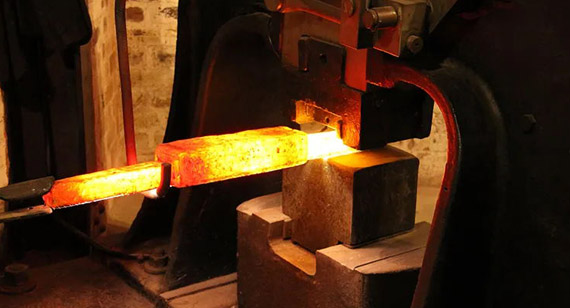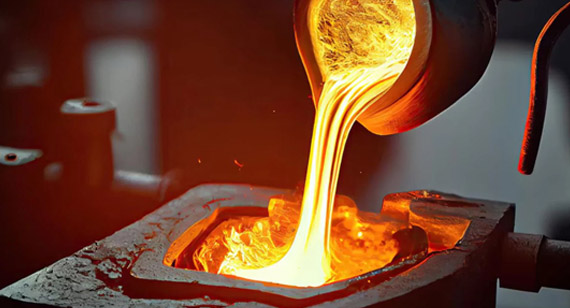15 years one-stop China custom CNC machining parts factory
 330 |
Published by VMT at Jul 21 2024
330 |
Published by VMT at Jul 21 2024
Casting and forging are two important and complementary processes in the metalworking industry. They have significant differences in raw material handling, process methods, product characteristics, and application ranges. Casting involves melting metal and pouring it into a mold to cool and solidify into shape, making it suitable for producing complex shapes, large quantities, and low-cost parts. Forging, on the other hand, uses pressure to deform solid metal plastically, ideal for manufacturing high-strength, high-precision, and relatively simple-shaped components. This article will delve into the differences between these two processes, their respective advantages, and factors to consider when choosing between them.
Forging is a metalworking technique that applies pressure to solid metal billets using a press or hammer, causing them to plastically deform to achieve the desired shape and size. The forging process includes heating the metal to a plasticity temperature, applying pressure for deformation, and cooling. This method significantly improves the internal structure of the metal, enhancing mechanical properties and density while reducing internal defects like porosity and shrinkage. Forged parts have high strength, toughness, fatigue resistance, and wear resistance, widely used in manufacturing critical components for automotive, aerospace, and marine industries.

Stronger Products: The forging process refines the metal grains and densifies the structure, improving overall product strength.
Higher Fatigue Strength: Forged parts have uniform internal structures without significant defects, making them suitable for components subjected to high cyclic stresses.
Toughness: Forged parts exhibit superior toughness compared to cast parts, better resisting impact and vibration.
Wear Resistance: The optimized fiber flow in the metal during forging enhances the wear resistance of parts.
Strength: Forged parts typically have higher tensile and yield strength than cast parts.
Reduced Defects: Forging can eliminate common casting defects such as porosity and shrinkage, improving product quality.
Lower Operational Costs: Although the initial investment in forging equipment is high, the superior performance of the products reduces maintenance and replacement costs, lowering overall operational expenses.
Diverse Shapes: With different mold designs, forging can produce parts in various complex shapes to meet diverse needs.
Casting is a process where molten metal or alloy is poured into a pre-made mold and allowed to cool and solidify into the desired shape and size. The casting process includes melting the metal, preparing the mold, pouring, cooling and solidification, and demolding. Casting can produce parts with complex shapes, uneven wall thicknesses, and a wide range of sizes at relatively low costs, making it suitable for mass production. A broad range of materials can be used for casting, including almost any metal or alloy that can be melted into a liquid state.

Fewer Size and Complexity Limitations: Casting is almost unrestricted by part size, wall thickness, and shape complexity, allowing the production of parts with complex shapes and intricate internal structures.
Flexible Quantities: Casting can produce single or small batch parts and is also suitable for large-scale production, offering flexible production methods.
Metal Choices: Casting can use various metal materials, including iron, steel, aluminum, copper, magnesium, and their alloys, providing a wide range of material choices.
Small Batch Production Capability: For small batch or customized needs, casting can quickly respond and offer flexible solutions.
Reduced Labor: The casting process has a high degree of automation, reducing manual operation, improving production efficiency, and enhancing safety.
Low Cost: The casting process is relatively simple, with lower equipment investment and higher material utilization, leading to lower production costs.
Finished Product Size and Weight: For large-size, heavyweight parts, casting might be more economical; forging is more suitable for producing simple-shaped, moderately weighted components.
Component Design: Parts with complex shapes and internal structures are more suitable for casting; parts requiring high strength and precision lean towards forging.
Alloy Selection: Different alloys have different forgeability and castability, so suitable materials should be chosen based on specific needs.
Internal Strength of the Part: Forged parts have uniform internal structures and high strength, suitable for components subjected to high stress and cyclic loads. Cast parts may have internal defects and relatively lower strength.
Cost of Cast and Forged Parts: Casting is cost-effective for large-scale production; forging has higher costs but offers superior product performance, suitable for high-quality demanding applications.
|
Metal Forging |
Metal Casting |
|
|
Structural Integrity |
Far superior in strength compared to castings. High level of material predictability |
Products tend to be more porous and more susceptible to breakage compared to forgings |
|
Tolerance |
Not well suited to highly complex geometries |
Allows for a high level of detail. Able to adhere to tight tolerances |
|
Product Size |
Limited in terms of the size and thickness of the metal (larger = more difficult) |
Compatible with a wide range of sizes |
|
Material Selection |
Selection of alloys is limited |
Compatible with nearly all types of metal |
|
Secondary Operations |
Usually requires secondary operations to refine and finish product to exact specifications |
Provides primary product that will usually require very few secondary operations |
|
Cost |
Tends to be most cost effective for medium to large production runs |
Generally, less expensive compared to forging, but it depends on the specific casting method used. |
Advantages of Casting
Low Cost: The casting process is simple, with high material utilization, suitable for large-scale production and relatively low cost.
Flexibility: Casting can produce parts with complex shapes and various sizes, meeting different needs.
Disadvantages of Casting
Internal Quality: Cast parts may have internal defects such as porosity and shrinkage, affecting mechanical properties.
Strength Limitations: Cast parts generally have lower strength than forged parts, making them unsuitable for high-stress environments.
Benefits of Forging
High Strength: Forged parts have uniform internal structures and high strength, suitable for high-stress, high-requirement components.
High Performance: Forging significantly enhances material toughness, fatigue resistance, and wear resistance, extending the part's service life.
Precise Control: The precise control during the forging process ensures part size and shape accuracy, meeting high-precision requirements.
Disadvantages of Forging
Higher Costs: Forging equipment and processes are complex, requiring higher costs for materials, molds, and technology.
Long Production Cycle: The forging process involves precise heating, forging, and cooling steps, resulting in a relatively long production cycle.
Material Limitations: Not all materials are suitable for forging, especially those with high melting points or difficult plastic deformation.
When choosing between casting and forging processes, it is essential to consider product-specific needs, cost-effectiveness, production cycle, and material properties. Casting, with its low cost, flexibility, and broad material applicability, dominates in mass production and complex shape part manufacturing. Forging, with its high strength, high performance, and precise control, is the preferred choice for high-precision, high-strength component production.
In practice, enterprises should flexibly choose or combine these processes based on their product characteristics, market demands, and technical capabilities to achieve optimal production efficiency and product quality. With continuous technological advancement, casting and forging processes are also innovating and improving, providing broader space and possibilities for manufacturing development.
As a leader in the industry, VMT CNC machining factory has advanced casting and forging equipment, a professional technical team, and extensive production experience. We are committed to providing customers with customized CNC machining solutions, including but not limited to casting CNC machined parts, forging CNC machined parts, and CNC prototype machining. Whether your needs are for mass production or custom designs, VMT can provide full-chain services from material selection and process design to finished product delivery based on your specific requirements.
Feel free to contact us to share your forging or casting needs. We will provide you with the most professional and efficient solutions to drive your product innovation and market competitiveness.
Is Forging Stronger than Casting?
Generally, yes. The forging process refines the metal grains and densifies the structure, giving forged parts higher strength and better mechanical properties. However, this is not absolute, as casting techniques are constantly improving, and optimized processes and new materials can also produce cast parts with high strength.
What Are the Disadvantages of Forged Parts?
The main disadvantages of forged parts include higher costs, longer production cycles, and material limitations. Forging equipment and processes are complex, requiring higher costs for materials, molds, and technology. The forging process involves precise heating, forging, and cooling steps, resulting in a relatively long production cycle. Additionally, not all materials are suitable for forging, especially those with high melting points or difficult plastic deformation.
Is Casting Cheaper than Forging?
In most cases, yes. The casting process is relatively simple, with high material utilization, suitable for large-scale production, and relatively low costs. However, this should be judged based on specific product requirements and production scale. In some cases, if forged parts can significantly improve product performance and service life, thereby reducing long-term maintenance costs, forging may be a more cost-effective choice.
Which is Better: Forged Aluminum or Cast Aluminum?
Forged aluminum and cast aluminum each have their advantages and application ranges. Forged aluminum has higher strength and excellent mechanical properties, suitable for components that need to withstand high stress and high requirements. Cast aluminum, on the other hand, has lower costs and better casting performance, suitable for manufacturing parts with complex shapes and various sizes. Therefore, when choosing between forged aluminum and cast aluminum, it is necessary to consider specific product requirements, cost-effectiveness, and production conditions.
